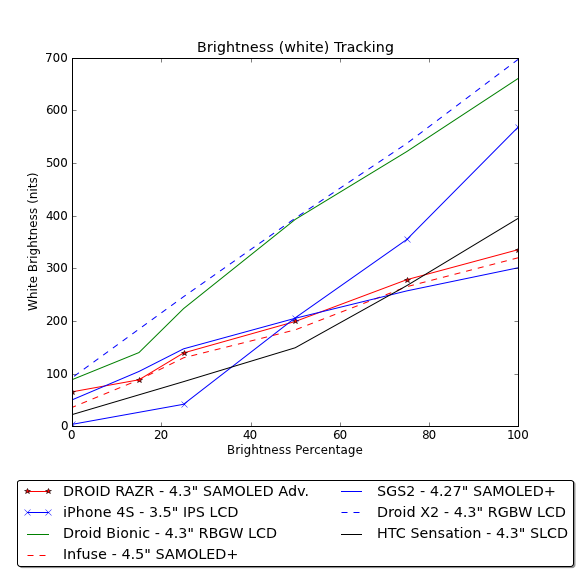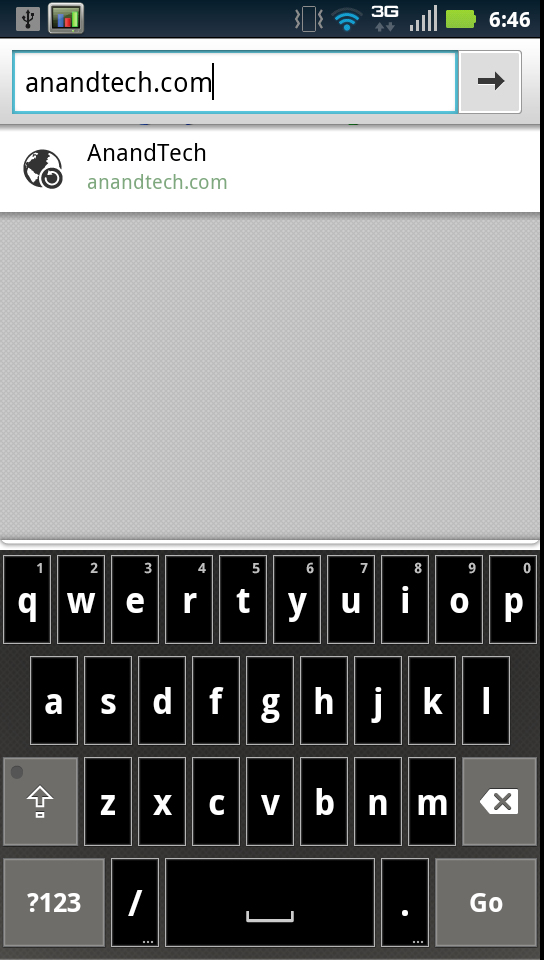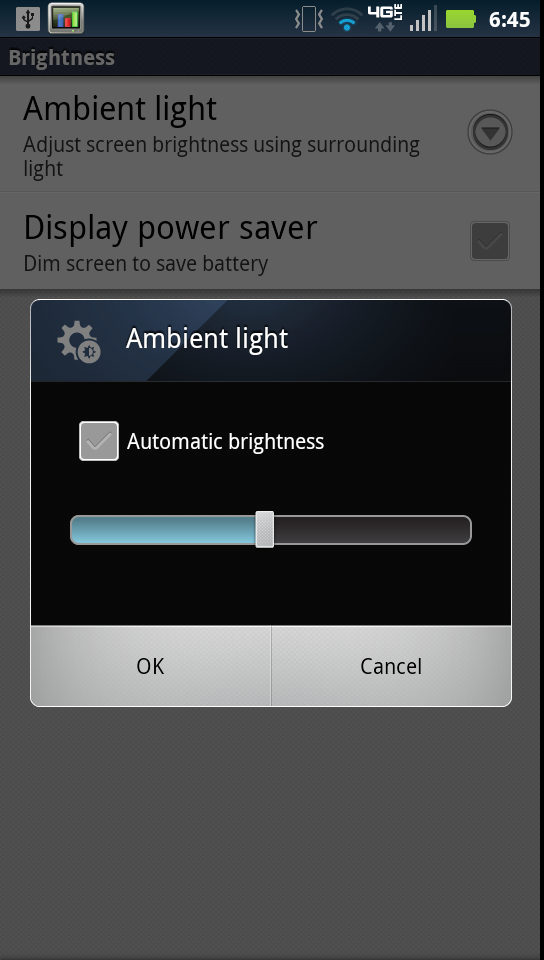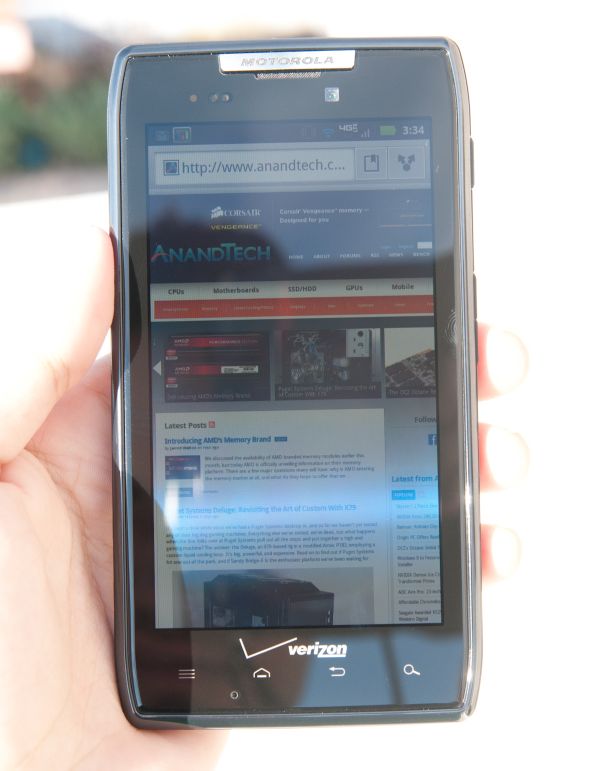Motorola Droid RAZR Review - A Better Clad Bionic
by Brian Klug on December 16, 2011 2:01 AM EST- Posted in
- Smartphones
- Droid
- LTE
- 4G
- Motorola
- Android
- Mobile
- Droid RAZR
- motorola droid RAZR
Super AMOLED Advanced Display
The RAZR is the first Motorola device to ship with an AMOLED panel, and in this case they’ve coined their 4.3” diagonal qHD (960x540) display Super AMOLED Advanced. True to AMOLED naming monikers, this panel includes RGBG PenTile (the absence of “Plus” tells you this one) and Advanced apparently now connotes qHD.
It seems like PenTile is something that mainstream press has finally become aware of, and for whatever reason, the RAZR served as lightning rod for others to voice their discontent with the non-RGB stripe subpixel rendering layout. Maybe it’s because the phone isn’t Samsung-branded (although ironically it is undoubtably manufactured by Samsung), but something about the RAZR display caused more than the usual scrutiny. I think a little bit of a history lesson is in order - since the original Atrix, Motorola has been shipping qHD LCD panels with the RGBW variant of PenTile. The fourth white subpixel helps the LCD system be more efficient - especially when displaying black text on a white background. In that system, luminance gets mapped to the white subpixel, chrominance to RGB.

Some AMOLEDs (Left to Right): SAMOLED (Galaxy S), SAMOLED+ (Galaxy S 2), SAMOLED Advanced (RAZR)
In AMOLED land thus far we’ve only seen RGBG PenTile or RGB subpixel matrixes. By taking advantage of the human visual system’s differing frequency response with respect to wavelength (eg we can detect higher spatial frequencies in the green), the system can emulate a higher resolution system with fewer subpixels. First and second generation AMOLED (“AMOLED” on the Nexus One and others, then Super AMOLED on the Galaxy S / Nexus S) drove an effective resolution of WVGA (800x480) at 3.7” and then 4”, and it was here that subpixels were big enough to pick out with the naked eye, especially on solid colors or single pixel thickness elements.
The thing that gets left out of most discussions about the RAZR’s display is that although RGBG is used, the subpixels have a different geometry than their RGBG first and second generation (AMOLED and Super AMOLED) partners from Samsung. Previously, green subpixels were noticeably thinner than their R and B partners. In this new matrix, they’re much closer to being same size (this also applies to the Galaxy Nexus and any of the new Samsung AMOLED panels that don’t use RGB stripes).
With respect to the RAZR, the combination of this more uniform subpixel geometry and higher effective resolution (qHD) at 4.3” makes RGBG PenTile nowhere near as visually noticeable as it was on phones like Galaxy S. I originally tweeted that I found the RAZR display visually different than other AMOLED panels with RGBG, and this is what I was referring to. Subjectively I’d even say that the RAZR has less characteristic PenTile grain than the RGBW LCD variants I’ve seen recently.
Of course the other side of the story is color rendering and accuracy. One of the most frustrating things with AMOLED that has existed in virtually every iteration is how white point varies sometimes wildly as a function of panel brightness. If you use auto brightness (which I wager almost everyone does to save battery), it can change dramatically and be accentuated by ambient lighting changes that accompany. I set out to measure how much change there is a while ago, and continue measuring brightness, contrast, and white point at different brightness percentages as set in the UI.


Like virtually all AMOLED displays I’ve seen, there’s subjective variance in appearance as a function of brightness. On the RAZR, the measurements with our i1D2 belies how big this is, and at the absolute lowest brightness settings greys can look somewhat green. Again we’ve seen this behavior on numerous AMOLED displays.

I also threw the RAZR at Color HCFR and took measures with Francois’ excellent voodoo screen test patterns application at 100% brightness. The results from a complete run (results in .chc format are here if you want them) are interesting. Starting with the CIE chart, we see the kind of oversaturation that has been long talked about with respect to AMOLED - the inside triangle is the sRGB standard, outside are primary and secondary measures.
Color temperature straddles 6500K and mirrors what measures I took and mentioned elsewhere, of course here we’re looking at it at different IRE values. Likewise, gamma is way above 2.2 and instead average 2.6.
Viewing angles and outdoor response are what we’re used to seeing from SAMOLED. That is to say viewing angles are awesome and outdoor response with an optically bonded panel and top glass isn’t anything to complain about.
I also haven’t seen the RAZR throw a display overheat warning and clamp display brightness either, which is more than I can say for virtually all of the SGS2 variants that I've seen, all of which will throw the overheat error if left in direct sunlight in my climate for too long.


There's two other little things to make note of. First, Motorola made a change to its standard multitouch keyboard and changed the keys to black - this is an interesting and nice little extra feature that might save a bit of battery power. Again, black on AMOLED literally corresponds to the pixels not emitting any light. Last, there's a display power saver checkbox which dims the screen when displaying darker content to save battery - this isn't any surprise, but it's just noteworthy that Samsung isn't alone in including sort of a dynamic contrast function in the guise of saving some battery.

















76 Comments
View All Comments
mfenn - Friday, December 16, 2011 - link
Dunno how many times I have to say this, but etc. is short for "et cetera". Putting more than one period in it is just plain wrong.jordanclock - Sunday, December 18, 2011 - link
Actually, when finishing a sentence with etc. it is correct to put a second period afterward, as the first one is to indicate an abbreviation and the second is to indicate the end of the sentence. It is acceptable to use just one period, but it is not incorrect to use two.BabelHuber - Friday, December 16, 2011 - link
A question to the Anandtech guys:Why don't you ever lose a word about rSAp (remote SIM Access Profile)?
I regularily use my phones in my car, where I want to use the built-in antenna when connecting my phone via bluetooth.
Connecting via Handsfree is really a PITA: The speech quality is bad and the phone's battery is stressed.
Hence for three years now I use rSAP, first in my Audi A5 and now in my BMW 5er (via the Snap-in adapter SAP from BMW).
I still have my good old Nokia X6, this one does rSAp very well. Android, OTOH, does not support rSAP (neither does iOS), but AFAIK e.g. Samsung added rSAP-capabilities to the Galaxy line.
I know that testing rSAP is not easy because of the different systems the various Auto makers use, but it would even be interresting if you could test it at least a little bit (e.g. checking if the Adress Book synchronization works or if one has to use the SIM card itself).
A phone without rSAP is useless for me, but perhaps I am part of a small minority, who knows.
Have you had any thoughts on rSAP?
Conficio - Friday, December 16, 2011 - link
Where are you located? I have not heard about that tech.But sounds very interesting. Especially as there is a big debate going on in the US about driving and using the phone.
BabelHuber - Friday, December 16, 2011 - link
I'm located in Germany, but I would think that rSAP is a global tech.It supported by VW/ Audi, Mercedes and BMW. For BMW, you need the 'Snap-in-adapter SAP', though.
With rSAP, the phone is put to standby-mode, since the phone itself is in the car. The car gets the SIM-card-information via bluetooth and also reads the address book, then you use its built-in phone.
It's a cool technology, the speech quality is very good, since the antenna of the car is used. Also there is almost no drag on the phone's battery, since it doesn't do anything at all.
The downside is that you cannot stream music from your phone to the car's stereo, you also can't use E-Mail with rSAP.
For me this is OK, though, I don't want to receive mails while driving and the car's stereo is fed by a USB-harddisk attached to it.
introiboad - Tuesday, December 20, 2011 - link
There is no technical reason for you not to be able to stream music even when using RSAP. They are 2 different profiles, RSAP and A2DP, and should be able to run in parallel. It's a limitation imposed by the car manufacturer, not by the spec.JonnyDough - Saturday, December 17, 2011 - link
Its not really a debate. Using a cell while driving should be illegal. When you're operating a vehicle that can take someone's life in a 30mph crash then your eyes, hands, and mind should be focused on the task of driving. I learned that in driver's ed and I believe its still part of the test to get a driver's license. Driving is a privilege and so many of the younger generations today have such a sense of entitlement..cheetahfox - Saturday, December 17, 2011 - link
As someone who was nearly killed because the person that hit my car was changing the radio station; there will always be distractions in a car. If you feel that Cell phones should be illegal then you should also ban all radio's, gps, cd-players and ipods. Further you should also make all cars have a single seat. We can't let someone talking to you distract you. You should also have some way to measure if a car is being driven by someone that is sleepy. It's been shown over and over again the lack of sleep is worse that drunk driving. I propose a mandatory system of cameras that monitor the driver of a car and if they detect that the person in question is sleepy and not attentive enough that they slowly cut power to the car and force them to pull over for a 30 min nap.I am taking it to an extreme but if we should ban cell phones, we should really ban many other things. Things that we would never ban, like more than one person in a car. The problem isn't the device, it's the person using it. If the person driving is a distracted driver(for whatever reason) and they cause an accident it should be handled with existing laws.
introiboad - Tuesday, December 20, 2011 - link
Remote SIM access profile is part of the Bluetooth Specification, it's just one of the profiles defined by the Bluetooth SIG. Unfortunately, RSAP never took off in the same way that HFP (Handsfree Profile) which is the profile that nearly every other phone available uses when connecting to a car.One of the reasons may be that RSAP requires the car to come bundled with a GSM baseband/radio since it only obtains the SIM info from the phone and then uses it to place calls using its own. On the other hand HFP simply instructs the phone to place the call using the phone's own GSM radio and then transfers the sound to the car. So it's clearly cheaper to include in a car since the car manufacturer doesn't need to include a Bluetooth _and_ a GSM radio.
introiboad - Tuesday, December 20, 2011 - link
As far as I know, only Symbian and Bada phones implement RSAP.